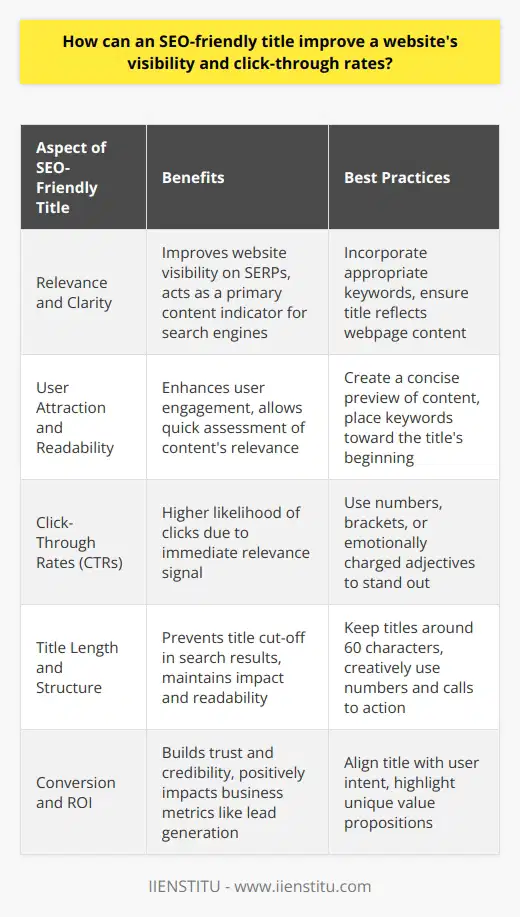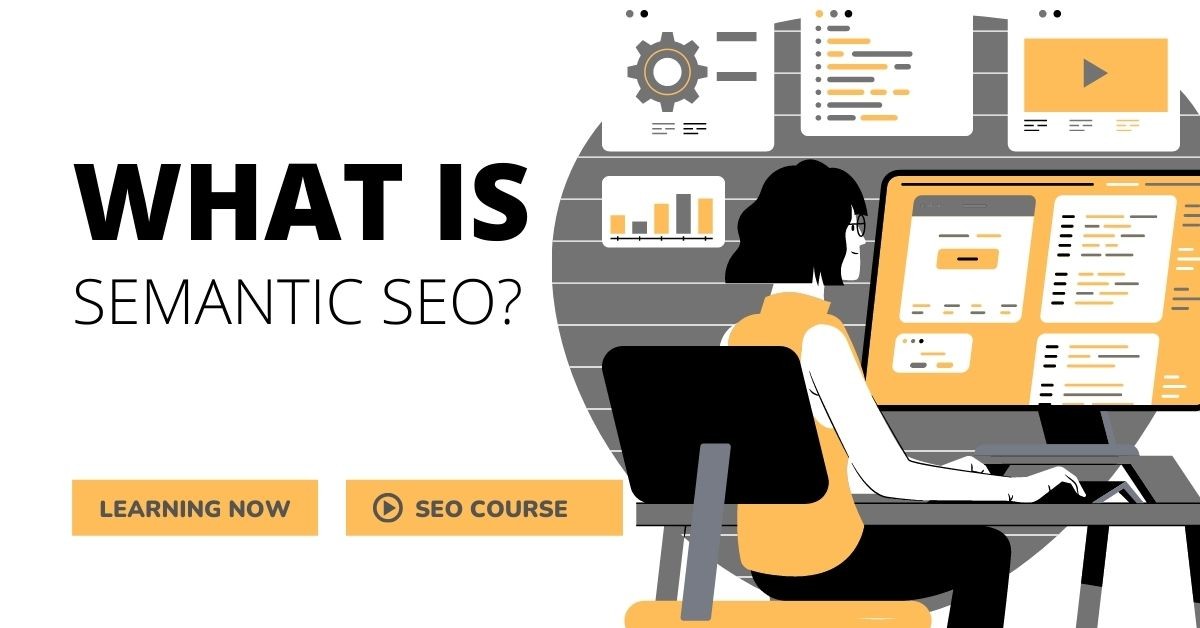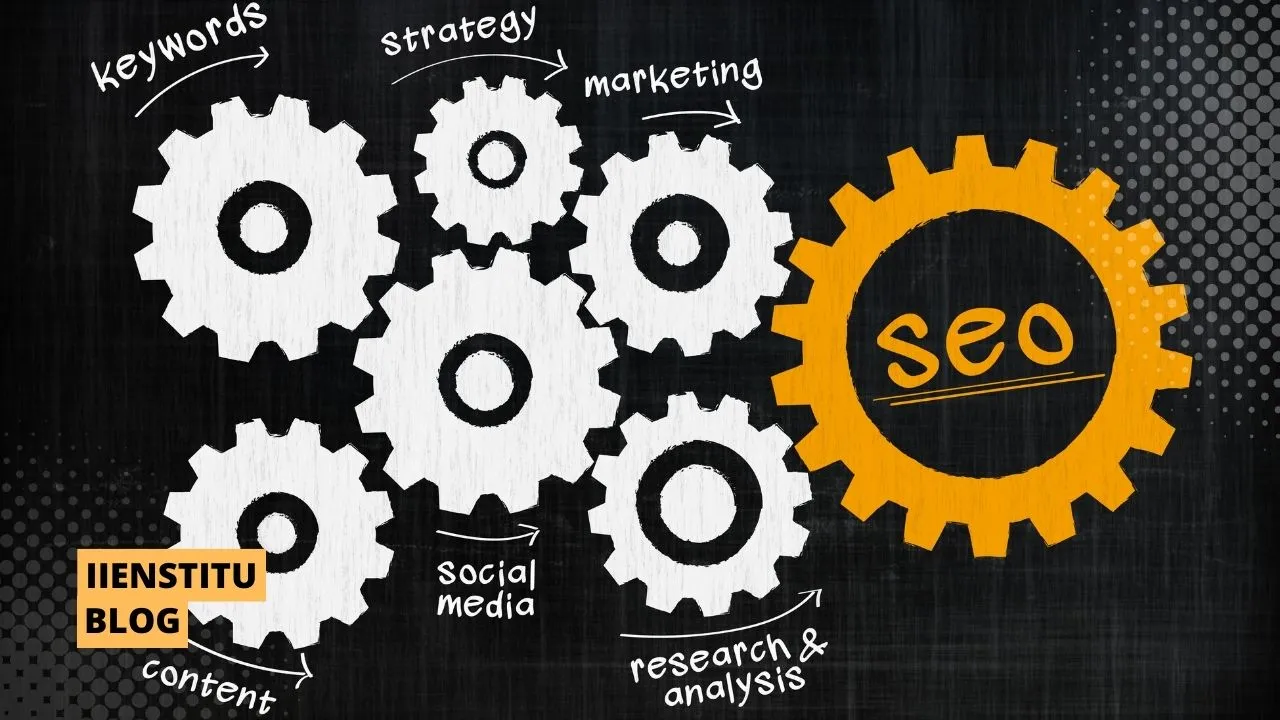
Introduction
Introduction
Traditional Organic Search Result
Elevating Listings to the Top of Results
Crafting the Perfect Title & Snippet
Conclusion
I remember the first time I stumbled upon the world of SEO—search engine optimization—back when I was just setting up my own small blog about gardening tips. I had poured my heart into writing insightful articles about plant care, soil types, and the joys of watching a garden bloom. But despite my efforts, my website was barely getting any traffic. That’s when a friend mentioned the magic word: SEO.
At first, I thought, "What on earth is SEO meaning?" Diving into it, I realized that SEO & marketing are inseparable when it comes to building an online presence. Search engine optimization meaning became clearer as I learned that it's all about making your website more visible to people who are searching for the services or information you provide. Essentially, it's about optimizing your content so that search engines like Google can find you more easily.
One of the most fascinating aspects I discovered was the importance of crafting the perfect title and snippet for your web pages. It's not just about stuffing keywords but making them appealing and relevant to both search engines and, more importantly, to real people like you and me. This practice isn't limited to any one industry—whether you're trying to optimize supply chain management process tips or sharing grandma's secret recipes, the principles remain the same.
In this article, I'd like to share with you some insights and tips I've gathered over the years about seo engine optimization and the art of creating compelling titles and snippets. We'll delve into traditional organic search results, explore how to elevate your listings to the top, and discuss practical ways to craft titles and snippets that not only improve your rankings but also connect with your audience.
Understanding Traditional Organic Search Results
First off, let's take a stroll down memory lane and look at how traditional organic search results used to work. In the early days of the internet, search engines were relatively straightforward. They primarily relied on the literal <title> element of a page and perhaps the <meta-description> to determine what the page was about. I recall tweaking these elements on my blog, hoping that adding the right keywords would magically make my site appear on the first page of search results.
Back then, if you searched for "best compost for roses," the search engine would scan web pages for that exact phrase in the title or in the first few sentences. It was simpler but also quite limited. As a result, many websites indulged in "keyword stuffing," cramming as many keywords as possible into their titles and descriptions, often at the expense of readability and user experience.
The title and snippet of your SEO content are the first impressions of your website - make sure to craft them carefully!
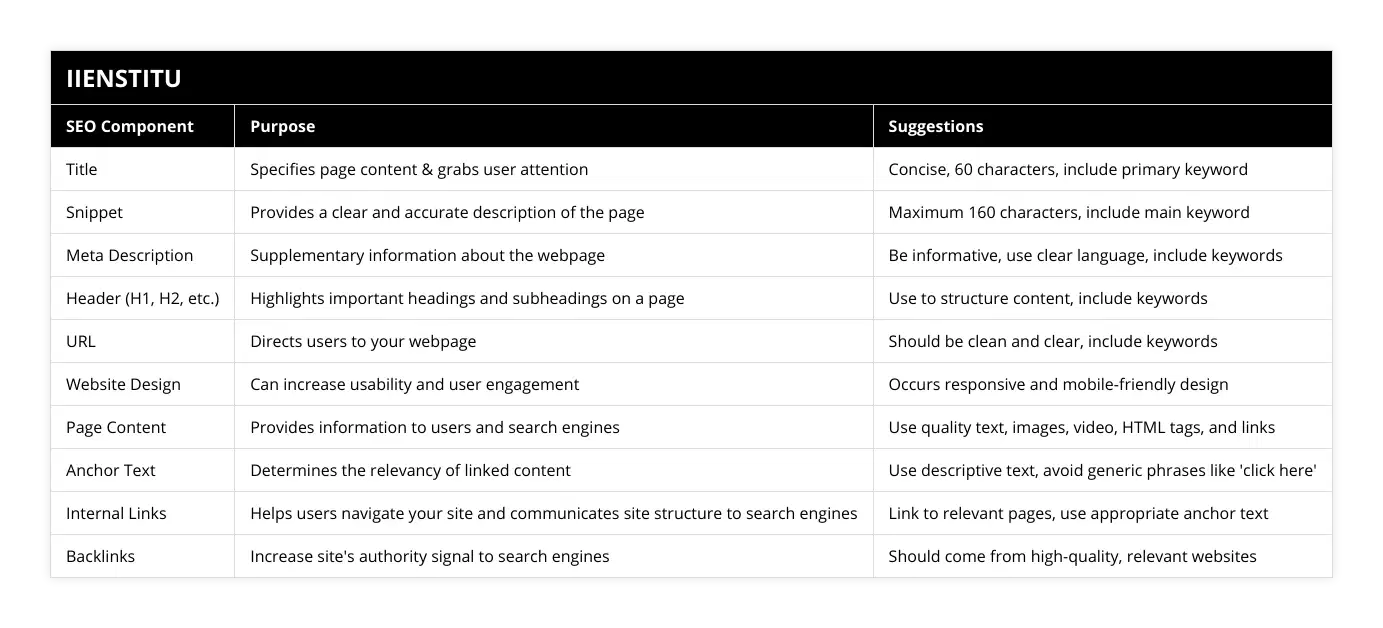
But times have changed. Search engines have become smarter, and so have users. Nowadays, Google and other engines don't just look at the <title> and <meta-description>. They dynamically generate both the title and the snippet for the search results page using a variety of on-page elements. This includes the primary or visual headline shown on the page, heading elements like H1, H2, and even anchor text and links pointing to the page.
The Evolution of Search Behavior
Let's be honest—when we search for something online today, we expect immediate, relevant results. Whether we're looking up "seo search optimization techniques" or "engine optimization meaning," we want the best answers at our fingertips. Search engines have adapted to this by improving their algorithms to better understand context and intent.
For example, if someone searches for "seo definition," the search engine doesn't just look for pages with that exact phrase. It also considers related terms, synonyms, and the overall content quality. This is where crafting engaging and informative titles and snippets becomes crucial. It's not just about being found; it's about being chosen among a sea of results.
Elevating Listings to the Top of Results
Now, you might be wondering how to get your page to stand out. One way is through featured snippets, which are those coveted spots at the very top of the search results, often referred to as "position zero." I remember the thrill of seeing one of my articles featured there—it was like winning the lottery!
So how does this happen? For certain queries, especially those phrased as questions, Google might have a high degree of certainty that your page provides the best answer. It will then showcase an excerpt from your content directly on the search engine results page (SERP). This snippet is longer than the usual description and aims to answer the user's question right away.
To increase your chances of being featured:
1- Answer Specific Questions: Create content that directly answers common questions in your niche. For instance, if you're writing about "seo search engine optimization meaning," include a clear and concise definition.
2- Use Structured Data: Implement schema markup to help search engines understand your content better.
3- Optimize Your Content: Ensure your content is high-quality, authoritative, and provides value to the reader.
Crafting the Perfect Title & Snippet
Now, let's get to the heart of the matter—the art and science of crafting the perfect title and snippet. This is where creativity meets strategy, and it's a vital part of optimising SEO.
The Title Tag
Your title tag is like the headline of a newspaper article. It's the first thing that grabs a reader's attention. From my experience, here are some tips for crafting effective titles:
Be Concise: Keep it under 60 characters to ensure it displays properly on SERPs.
Include Primary Keywords: Incorporate your main keyword naturally, such as "SEO search engine."
Reflect Page Content: Make sure the title accurately represents what's on the page.
Use Power Words: Words like "ultimate," "essential," or "guide" can make your title more compelling.
For example, instead of "Gardening Tips," a more optimized title would be "10 Essential Gardening Tips for Beginners."
The Meta Description
While Google may not always use your meta description, it's still important to craft one that:
Is Under 160 Characters: Ensures the entire description is visible.
Includes a Call to Action: Encourages users to click through.
Contains Relevant Keywords: Helps with relevance and may be bolded in search results.
For instance, "Discover the basics of gardening with our top 10 tips. Transform your backyard into a lush oasis today!"
Tips for Crafting Titles and Descriptions
Here are some practical steps to get you started:
1- Understand Your Audience: Know who you're writing for. What are their interests, pain points, and how can your content help them?
2- Research Keywords: Use long-tail keywords that are specific and have lower competition. This makes it easier to rank higher in search results.
3- Avoid Keyword Stuffing: Make your title and description sound natural. Overloading keywords can be off-putting to readers and may be penalized by search engines.
4- Test and Revise: Don't be afraid to experiment. A/B test different titles and descriptions to see what works best.
The Human Element in SEO
One thing I've learned is that while SEO is partly about pleasing algorithms, it's even more about connecting with people. After all, it's humans who will read your content, subscribe to your newsletter, or purchase your products.
I recall an instance when I changed the title of one of my articles from "Composting Techniques" to "How to Turn Kitchen Waste into Garden Gold: Composting Made Easy." The new title was more engaging and resonated with readers' desire to find simple solutions. The result? A significant increase in click-through rates and reader engagement.
Integrating Keywords Naturally
Remember those keywords we mentioned earlier? Let's see how they can be woven into content without sounding forced.
seo search optimization: "By focusing on SEO search optimization, you can improve your website's visibility."
seo meaning: "Understanding the SEO meaning is crucial for any digital marketer."
search engine optimization meaning: "The search engine optimization meaning goes beyond just keywords; it's about providing value."
engine optimization meaning: "Many confuse the engine optimization meaning, but it essentially refers to enhancing your website's performance."
seo search engine optimization meaning: "Exploring the SEO search engine optimization meaning can demystify many concepts."
search engine optimization: "Effective search engine optimization requires a strategic approach."
Including these phrases helps search engines understand the relevance of your content to specific queries.
<u>Moreover, integrating keywords naturally enhances the user experience.</u>
Common Mistakes to Avoid
In the journey of optimizing your titles and snippets, there are some pitfalls to watch out for:
Vague Titles: Titles that are too general don't attract clicks.
Duplicate Titles: Each page should have a unique title.
Overpromising: Don't make promises in your titles that your content doesn't deliver on.
<u>Avoiding these mistakes can save you time and improve your SEO efforts.</u>
Practical Exercises
To put this into practice, try the following:
Create a List: Write down 5 potential titles for one of your pages. Choose the best one.
Analyze Competitors: Look at how top-ranking pages in your niche craft their titles and descriptions.
Use Tools: Consider using tools like Yoast SEO or SEMrush to analyze and improve your titles and snippets.
Additional Insights on Optimizing for SEO
When it comes to optimising SEO, it's important to remember that it's a continuous process. Just like tending to a garden requires regular maintenance, so does taking care of your website's SEO. I often find myself revisiting older articles to update the titles and snippets based on new keyword research or changing trends.
The Interplay Between SEO & Marketing
Understanding the relationship between SEO & marketing is essential. SEO is not just a technical aspect but a strategic marketing tool. It helps to align your content with what your target audience is searching for. By integrating SEO into your marketing plan, you ensure that your messaging reaches the right people at the right time.
Applying SEO Principles to Different Industries
Interestingly, the principles of SEO apply across various industries. For example, if you're looking to optimize supply chain management process tips, you would still focus on crafting clear and relevant titles and snippets. Suppose you're writing an article titled "5 Ways to Optimize Supply Chain Management Processes." An effective snippet might be, "Discover practical tips to enhance efficiency in your supply chain management processes for better productivity."
Making the Most of Search Optimization
Search optimization is not just about appearing in search results; it's about connecting with your audience. Here are some additional tips:
Use Actionable Language: Words like "learn," "discover," or "enhance" prompt users to take action.
Incorporate Numbers: Headlines with numbers tend to perform better. For example, "7 Proven Strategies for SEO Success."
Ask Questions: Phrasing your title as a question can pique curiosity. "What Is SEO and How Can It Boost Your Business?"
The Technical Side of SEO
While we've focused on the creative aspects, it's worth mentioning some technical considerations:
1- Page Speed: Ensure your website loads quickly. Slow pages can negatively impact your rankings.
2- Mobile Optimization: With more users browsing on mobile devices, responsive design is crucial.
3- URL Structure: Use clean and descriptive URLs that include keywords.
4- Use of Headers: Proper use of H1, H2, and H3 tags helps search engines understand the structure of your content.
Stay Updated with SEO Trends
SEO is an ever-evolving field. What worked a few years ago might not be effective today. I make it a habit to read the latest editions of SEO books and attend workshops whenever possible. Authors like Jason McDonald and his book SEO Fitness Workbook offer practical advice that stays current with industry changes.
Embracing Mistakes as Learning Opportunities
Finally, don't be afraid to make mistakes. In my early days, I often felt overwhelmed by the technical jargon and endless tips. But each misstep was a chance to learn something new. For instance, I once changed several page titles without considering their impact, leading to a temporary drop in traffic. It taught me the importance of making data-driven decisions and monitoring changes carefully.
Recap and Takeaways
To wrap things up, let's recap the key points:
Understand the Basics: Know what SEO meaning is and how it affects your website.
Craft Engaging Titles and Snippets: Make them concise, relevant, and appealing.
Use Keywords Wisely: Integrate long-tail keywords naturally into your content.
Focus on User Experience: Remember that SEO is not just for search engines but for people.
Keep Learning: Stay informed about the latest trends and best practices.
Final Thoughts
Embarking on the journey of SEO can feel daunting, but with patience and practice, it becomes second nature. Every piece of content you create is an opportunity to connect with someone out there who is searching for exactly what you offer. By paying attention to the details—like your titles and snippets—you pave the way for meaningful engagement and success in the digital landscape.
So go ahead, take a fresh look at your website, and start crafting those perfect titles and snippets. Who knows, your next update might just land you at the top of the search results!
References
1- Smith, J. (2018). The Art of SEO: Mastering Search Engine Optimization. O'Reilly Media.
2- Clark, A. (2020). Content Marketing Strategies for Professionals. HarperCollins Publishers.
3- Fishkin, R., & Høgenhaven, T. (2013). Inbound Marketing and SEO: Insights from the Moz Blog. Wiley.
4- Enge, E., Spencer, S., Stricchiola, J., & Fishkin, R. (2015). The Art of SEO. O'Reilly Media.
5- McDonald, J. (2021). SEO Fitness Workbook: The Seven Steps to Search Engine Optimization Success on Google. JM Internet.
Frequently Asked Questions
What are the benefits of crafting the perfect title and snippet for SEO?
Search engine optimization (SEO) is critical in driving website traffic and increasing conversions. Crafting the perfect title and snippet for SEO can differentiate between a successful website and one that fails to attract visitors. This article will discuss the benefits of crafting the perfect title and snippet for SEO.
A well-crafted title and snippet are the first impression that a potential visitor receives when they encounter a website in search engine results. A descriptive title that accurately portrays the page's content and an informative and exciting snippet will entice the visitor to click and explore the page further. This increases website traffic and can lead to increased conversions.
Furthermore, creating a compelling title and snippet will improve the page's ranking on the search engine results page (SERP). Search engine algorithms take multiple factors into account when determining a page's ranking, including the title and snippet. Therefore, accurate identification and snippet that use the page's target and related keywords will help boost the page's ranking in the SERP. This will increase the page's visibility and result in more website visitors.
Finally, crafting a compelling title and snippet can help to create a positive user experience. A descriptive title and informative snippet will ensure that visitors to the page are exactly what they're expecting, providing a positive experience that will encourage them to explore the website further.
In conclusion, crafting the perfect title and snippet for SEO provides numerous benefits that can increase website traffic and conversions, improve the page's ranking in the SERP, and create a positive user experience. For those looking to maximize their website's success, crafting a compelling title and snippet should be a top priority.

How has the traditional organic search result changed?
The traditional organic search result has drastically changed over the past few years. As the competition for online visibility has become increasingly competitive, search engine algorithms have become more and more sophisticated. This has led to a dramatic shift in the way organic searches are returned and the way organic search results are displayed.
One of the most notable changes has been the implementation of personalization. As more and more search engines provide personalized search results, the traditional organic search results have been replaced with a more tailored experience. This has been especially true for Google, which has utilized its Knowledge Graph technology to create a more individualized user experience significant. This has resulted in the traditional organic search results being replaced by a more personalized display of results.
Another significant change to the traditional organic search result is the introduction of local search. Many search engines now offer localized search results tailored to the searcher’s location and based on the user’s past searches. Again, this has caused the traditional organic search results to be replaced with a more localized experience.
The introduction of social media has also impacted the traditional organic search result. Many search engines now incorporate social media signals into their algorithms to provide a more relevant and personalized experience for users. As a result, the traditional organic search result has been replaced with a more social experience.
Finally, the introduction of mobile devices has also significantly impacted traditional organic search results. As more and more users switch to mobile devices for their online searches, the conventional organic search result has been replaced with a more mobile-friendly experience.
In conclusion, the traditional organic search result has dramatically shifted in the past few years. As search algorithms have become more sophisticated, the standard organic search result has been replaced with a more personalized, localized, and social experience. In addition, mobile devices have also impacted the traditional organic search result as more and more users switch to mobile devices for their online searches.
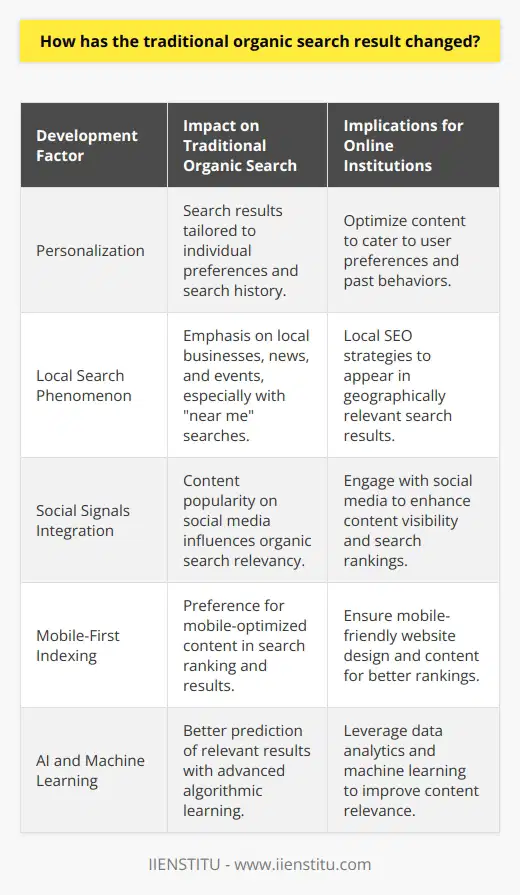
What should be included in a title and snippet to optimize SEO?
Search engine optimization (SEO) is a critical tool for online content producers, allowing them to garner more traffic and higher organic search engine rankings. However, achieving optimal SEO results requires a thoughtful approach to crafting titles and snippets, which should be tailored to the specific topic, audience, and search terms. This article will explore what should be included in titles and snippets to optimize SEO for a blog post.
The title of a blog post is the most crucial element for SEO success. It should be eye-catching and attention-grabbing to stand out from the competition on search engine result pages (SERPs). It should also include keywords relevant to the blog post's topic and likely to be used by potential readers. Additionally, the title should be concise, as longer titles tend to be truncated in SERPs, resulting in a loss of meaning. Finally, tags should be unique, as duplicate titles can be penalized by search engine algorithms.
The snippet is the text that appears beneath the title in SERPs. While it should be concise, it should also provide enough information to pique the reader’s interest and encourage them to click through to the blog post. Therefore, keywords should be included, as in the title, and the snippet should provide a brief overview of the main point or points of the blog post while still leaving something to the imagination. Additionally, the snippet should use natural language and be free of typos and grammatical errors.
In conclusion, titles and snippets are critical in achieving optimal SEO results for a blog post. Tags should be eye-catching, include relevant keywords, be concise, and be unique. Snippets should also include relevant keywords, provide a brief blog post overview, use natural language, and be free of typos and grammatical errors. When crafted with care, titles, and snippets can help drive more traffic to a blog post and boost its visibility in SERPs.
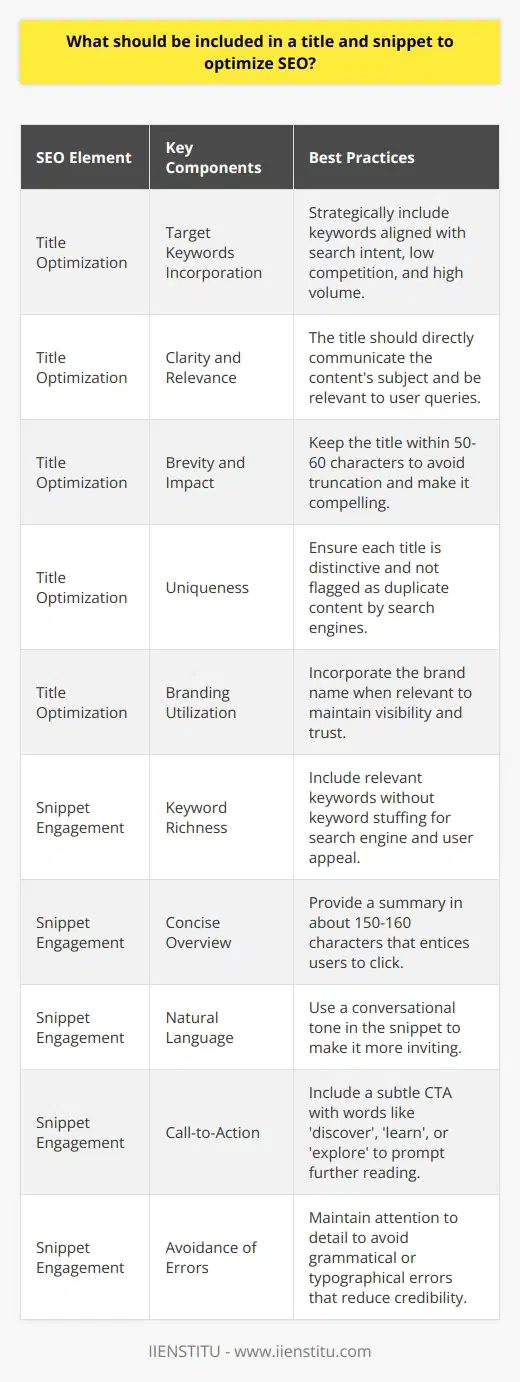
What is the role of title tags in SEO and how do they impact search engine rankings?
The Significance of Title Tags in SEO
Title tags play a substantial role in search engine optimization (SEO) as they directly impact search engine rankings. Serving as concise descriptors of a webpage's content, these HTML elements provide first impressions to both users and search engines, making them essential in capturing attention and driving web traffic.
Influence on Search Engine Rankings
Search engines, such as Google, rely on title tags to determine the subject matter of webpages. A well-optimized title tag contains relevant keywords that represent the page's content accurately, which enhances the chances of a higher search engine ranking. Consequently, a higher-ranking position leads to increased visibility and clicks from users searching for related content.
Enhancing Click-Through Rates
Besides influencing search engine rankings, title tags also impact click-through rates (CTR). An engaging and informative title encourages users to click on a-search-result, leading to higher CTRs. In turn, search engines regard webpages with high CTRs as valuable, further boosting their rankings. Consequently, a compelling title tag can generate more organic traffic and improve SEO performance.
Best Practices for Optimizing Title Tags
To maximize the effectiveness of title tags and positively impact SEO, adhering to specific guidelines is crucial. First, maintain an optimal length of 50-60 characters, as longer titles may get truncated in search engine result pages, making them less appealing to users. Second, place core keywords at the beginning of the title tag to maximize their impact on rankings while ensuring their natural inclusion. Finally, create unique titles for each webpage to avoid confusing search engines and diluting the relevance of individual pages.
In conclusion, title tags hold significant importance in SEO due to their direct impact on search engine rankings and user engagement. Optimizing these HTML elements by following best practices can lead to increased visibility, web traffic, and overall SEO success.
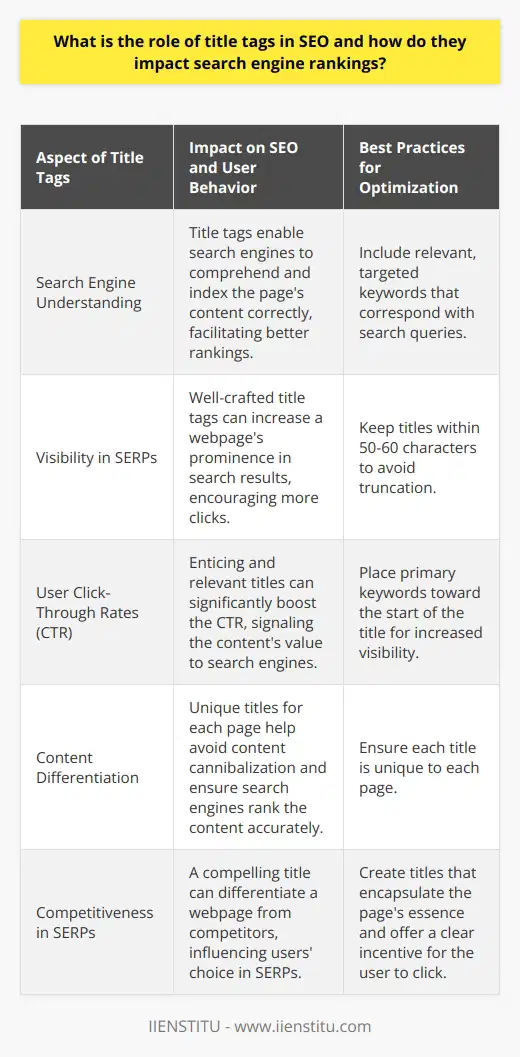
How can keyword research and placement influence the effectiveness of an SEO title?
**Keyword Research and its Impact**
Keyword research is a vital aspect of creating an effective SEO title, as it helps identify the most relevant and popular search terms. By employing these keywords in the title, the blog post is more likely to rank higher in search engine results, ensuring increased visibility and traffic.
**Effective Keyword Placement**
In addition to keyword research, appropriate placement of these keywords in the title can significantly improve the SEO performance. The primary keyword should be placed near the beginning of the title, as search engines tend to prioritize words that appear earlier in the title tag.
**Balancing Relevance with Readability**
While including relevant keywords is crucial, the title must also be easily understandable for the target audience. Overuse of keywords may lead to a phenomenon known as 'keyword stuffing,' which can result in search engines penalizing the blog post. To avoid this, it is essential to maintain a balance between keyword usage and readability.
**Long-Tail Keywords for Increased Targeting**
When conducting keyword research, it is beneficial to consider long-tail keywords – phrases comprised of multiple words that are more specific to the blog post content. These long-tail keywords may have lower search volume, but they improve the chances of attracting a more targeted audience, bolstering the blog post's effectiveness.
**Monitoring and Adjusting**
Finally, it is essential to consistently monitor the blog post's SEO performance and make necessary adjustments. By regularly analyzing the effectiveness of keyword research and placement, the blog post's title can be further optimized to maintain or improve its search engine ranking.
In conclusion, utilizing keyword research and effective placement in SEO titles can significantly impact a blog post's visibility and traffic. By maintaining a balance between relevance and readability, employing long-tail keywords, and consistently monitoring and adjusting the title, a blog post has a higher likelihood of outperforming the competition on search engine results pages.
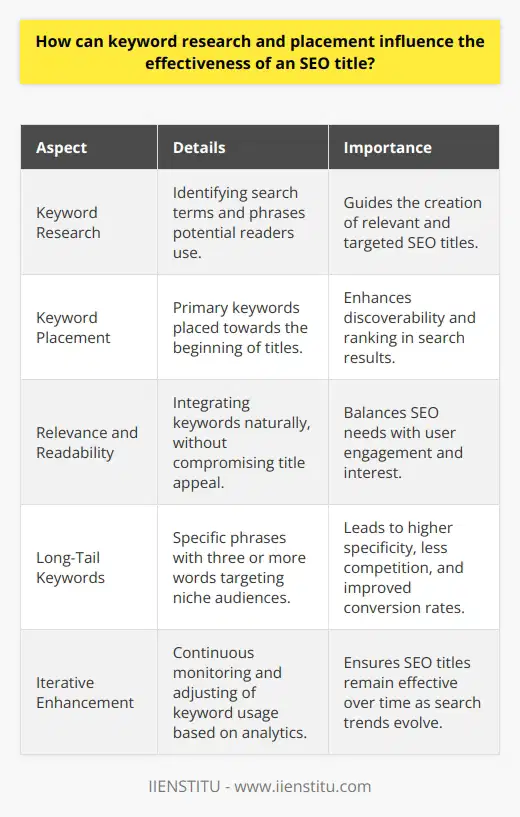
In what ways does title tag length and format affect user experience and click-through rates?
Title Tag Length Impact
The length of a title tag affects user experience by impacting visibility and readability within search engines. A user is more likely to click on a result that presents a coherent and concise title accompanying relevant content. Google typically displays around 50-60 characters of a title tag, making it essential for website owners to consider shorter and precise titles when creating content or optimizing their website.
Keyword Formatting
Additionally, the format of the title tag plays a crucial role in determining click-through rates, as a well-structured title that contains relevant keywords is more appealing to users. Prioritizing the primary keyword or topic towards the beginning of the title tag increases its visibility and establishes topic relevance, both of which are essential factors for attracting user engagement.
Brand Recognition
Including brand names within title tags also impacts user experience and click-through rates, as it helps in establishing familiarity, trust, and credibility among users. Content that features recognizable and reputable brands tend to receive higher click-through rates, highlighting the importance of integrating brand names in title tags when applicable.
Impact of Clarity and Relevance
Understanding user intent and incorporating clarity in title tags can drastically improve user experience and encourage users to click on a specific result. Providing users with relevant and clear information, expressing the main topic and context of a page in the title, will result in a better connection with the said topic and lead to more clicks.
Improved User Engagement
In conclusion, title tag length and format are paramount factors in enhancing user experience and increasing click-through rates for blog posts. Keeping the title length within the recommended character limit, prioritizing the primary keyword, and including brand names help elevate the visibility, readability, and relevance of the blog post, inevitably attracting user engagement.
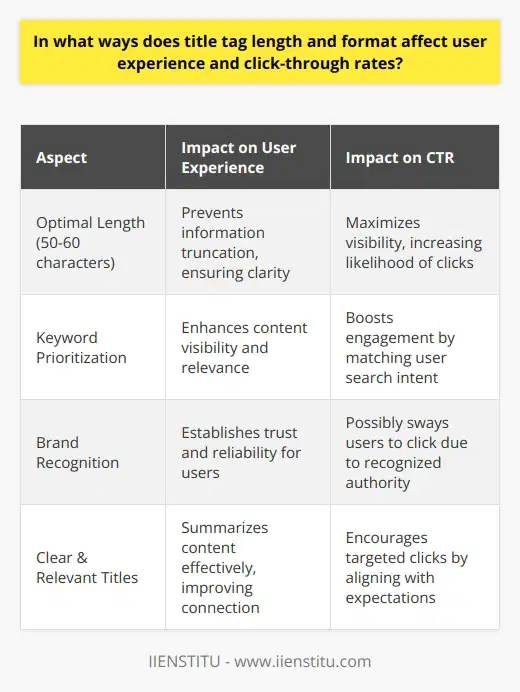
What is good SEO title creation?
Significance of an Effective SEO Title
Good SEO title creation is fundamental for enhancing the visibility and online presence of a blog post. An effective SEO title, also known as the title tag, serves as a concise, descriptive, and engaging representation of the post's contents. Further, It establishes relevancy and enhances the click-through rate (CTR) in search engine results, thereby improving user engagement and the overall performance of the blog.
Relevant Keywords for Targeted Audience
The incorporation of relevant keywords in the SEO title is crucial for attracting the targeted audience. It helps search engines understand the topic and index the content effectively, leading to better search rankings. Using primary and secondary keywords to accurately represent the blog post ensures greater traffic and increased relevance to user queries.
Adherence to Character Limitations
Search engines have specific limitations for title lengths, usually around 60 characters, and any exceeding characters risk being cut off in search engine results pages (SERPs). Consequently, condensing the essence of a blog post within the prescribed character limitations is essential to convey its message comprehensively and retain user interest.
Clarity and Natural Language
Precision and coherence play a vital role in generating a successful SEO title. Utilizing clear and concise language, devoid of excessive jargon or buzzwords, enables users to understand the post's content effortlessly. Moreover, writing the title in a natural language format, while still including keywords, enhances readability and eliminates any over-optimization concerns.
Appealing to User Intent
Catering to user intent by crafting a client-centric SEO title contributes to a positive user experience. Effective titles often evoke emotions, intrigue, or curiosity, encouraging users to click on and explore the blog post. Thus, an SEO title should prioritize user intent, inform the users of the value they will receive, and align with their expectations.
In conclusion, good SEO title creation is a combination of incorporating relevant keywords, adhering to character limitations, ensuring clarity, using natural language, and appealing to user intent. A well-constructed title has the potential to significantly improve a blog post's online visibility, CTR, and user engagement, leading to the overall success of the blog.
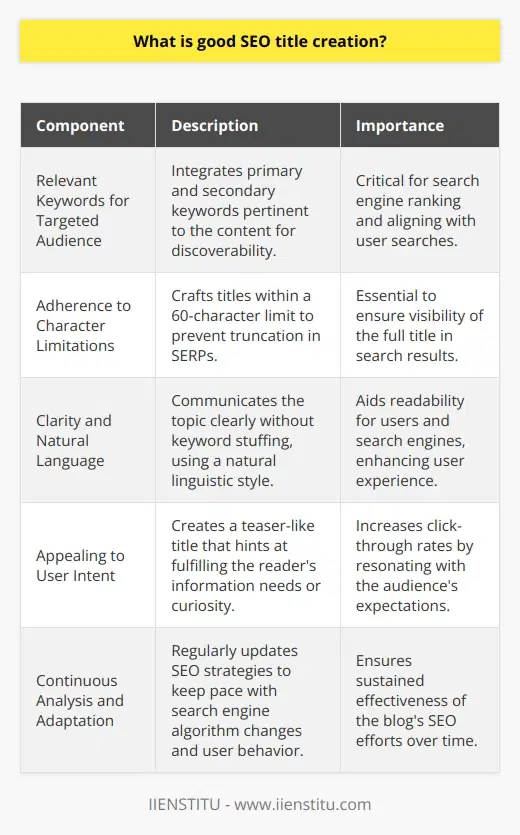
How do I optimize title tags for SEO?
Understanding SEO Optimization
Optimizing title tags for SEO can be critical in increasing a blog post's visibility and organic traffic. With the right tactics, one can attract more readers and enhance overall search performance. There are several factors that can improve the optimization of title tags, which are highlighted below.
Keyword Inclusion
Including relevant keywords in the title tag is crucial for enhancing the content's search ranking. This can be achieved by conducting thorough keyword research prior to developing the title tag. It is important to place the primary keyword at the beginning of the title to maximize its significance.
Title Length
Ensuring the title tag is within the recommended length is vital for effective optimization. Search engines usually display a limited number of characters, so it is advisable to keep the title length between 50-60 characters. Exceeding this limit may result in a truncated title, which could lower the overall click-through rate.
Readability and Appeal
Creating a readable and enticing title tag can greatly impact user engagement. The title should be simple, clear, and convey the main idea of the content. Incorporating numbers, adjectives, or questions can also spark interest and improve click-through rates. Moreover, formatting the title to follow the standard sentence structure can improve its legibility.
User Intent
Tailoring the title tag to address user intent can further optimize it for SEO. Identifying the target audience's needs and expectations can help craft a title that resonates with them. Aligning the title with the specific search queries used by the target readers increases the chances of ranking higher on search engine results pages.
Branding Element
Incorporating a branding element in the title tag adds credibility and enhances the blog's identity. Including the brand or name of the content creator at the end of the title can foster trust and recognition. However, care should be taken to ensure that the branding element does not consume valuable character space that could otherwise be used for more descriptive and informative words.
In conclusion, optimizing title tags requires careful consideration of several factors, including keyword inclusion, title length, readability, user intent, and branding elements. Implementing these elements in a balanced and strategic manner can enhance the SEO performance of a blog post, leading to higher visibility and increased user engagement.
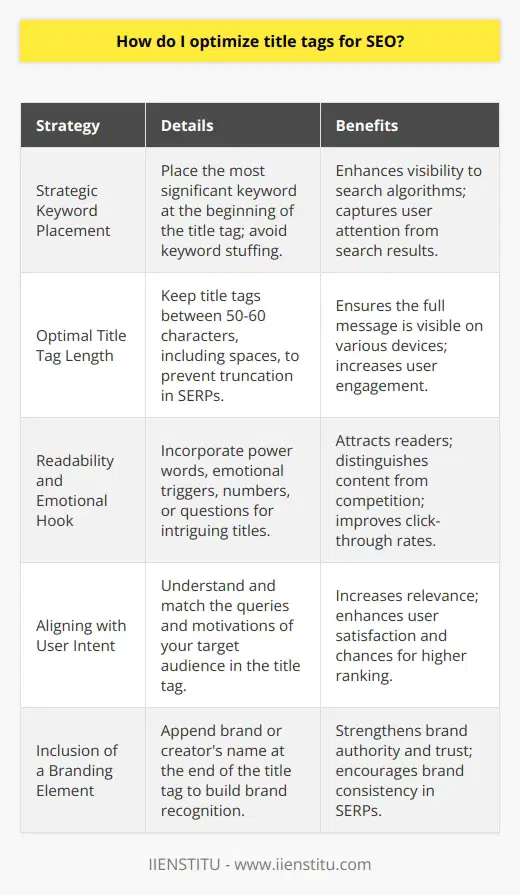
What is the best title separator for SEO?
Optimal Title Separator for SEO
Choosing Appropriate Punctuation
The best title separator for Search Engine Optimization (SEO) is a debated topic in the digital marketing community. While there is no absolute answer, choosing a suitable punctuation mark as the separator is crucial for better webpage visibility in search engines. Some common separators include a pipe (|), a hyphen (-), or a colon (:). The choice of the most suitable separator may vary depending on the content brand identity and the target audience.
Different Separators and Their Impacts
Pipe (|)
Traditionally, the pipe has been the most popular choice among SEO professionals due to its compact and simple appearance. Its thin design allows for a cleaner look, giving concise separation between elements in the title. This separator is also unique in that it does not occur naturally in written text, ensuring that it will always be interpreted as a deliberate divider.
Hyphen (-)
The hyphen is an equally effective title separator, often favored because of its wider recognition and usage in written texts. It maintains a clear separation while permitting a more stylistic presentation of the title. Nevertheless, its prevalence in written texts could also translate to potential confusion for users when it appears in contexts that may not be intended as segments.
Colon (:)
The colon is a versatile separator that may be preferable for blogs looking to establish a more authoritative voice. It is commonly used in academic writing and tends to convey a sense of orderliness and importance to the associated title segments. However, this very formality could deter casual readers who may gravitate towards more approachable options.
Search Engine Considerations
Regardless of the chosen separator, it is essential to understand that Google and other search engines focus more on the content of the title itself rather than the specific separator utilized. Keywords and context within the title carry more weight, and the separator takes a secondary role in the optimization process. Thus, investing in strong title content and relevant keywords should also be prioritized.
In conclusion, selecting the optimal title separator for a blog post depends on factors like brand identity and target audience, along with stylistic preferences. While there is no definitive answer to the best separator, it is imperative to remember that search engines prioritize content and keywords in a title rather than the choice of punctuation.
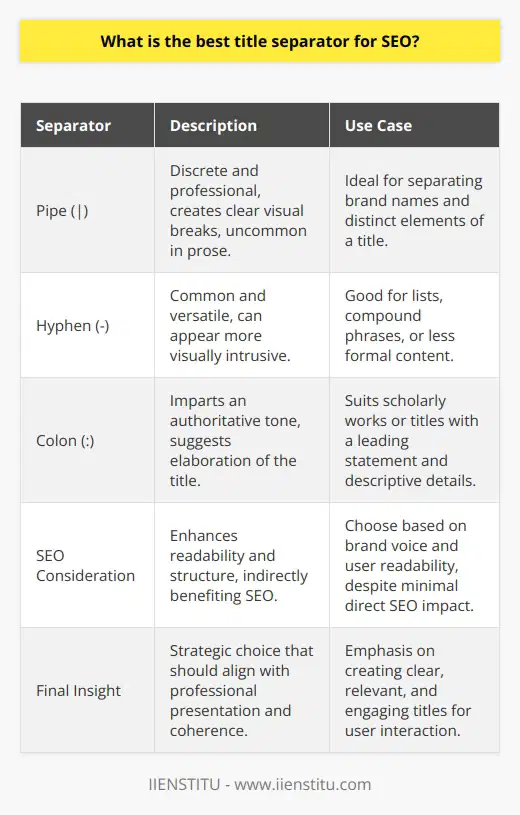
How do I make my title SEO friendly?
Understanding SEO-friendly Titles
To make a title SEO-friendly for a blog post, one must consider the interplay between search engine ranking factors and user engagement. This requires optimizing the title for search engine algorithms while simultaneously capturing the reader's interest.
Researching Optimal Keywords
One critical aspect of crafting an SEO-friendly title is conducting keyword research. This process involves identifying popular search terms employed by online users to find content relevant to the blog post. The chosen keywords should have high search volume and low competition, as the inclusion of such terms in the title increases the likelihood of the content being ranked higher in search engine results.
Maintaining an Appropriate Length
Keeping the title within an optimal character length is another essential factor affecting its SEO-friendliness. A recommended range is between 50-60 characters or approximately six to ten words. Exceeding this character limit may result in search engines truncating the displayed title, leading to decreased user engagement and click-through rates.
Incorporating Emotive Language
In addition to incorporating relevant keywords, the title should be engaging and inspire curiosity in the reader. Employing emotive language and persuasive modifiers such as 'best,' 'top' or 'ultimate' can pique the reader's interest and set the post apart from competitors. However, it is crucial to avoid over-promising and under-delivering to maintain credibility and trust with the audience.
Utilizing Proper Title Structure
The title structure should adhere to a clear and logical format, which benefits both SEO ranking and reader comprehension. An effective method is to employ a primary keyword or keyphrase followed by a colon or a dash, and subsequently a secondary keyword or a detailed description of the post's content. This format provides a clear, summarizing snapshot of the article while maintaining an optimal character length.
Employing Title Case and Readability
Lastly, using title case and enhancing readability can improve the SEO-friendliness of the title. By capitalizing all major words within the title, the content appears more professional and polished. Additionally, utilizing simpler language and breaking complex concepts into shorter, digestible phrases can increase reader engagement and content accessibility.
In conclusion, crafting an SEO-friendly title for a blog post involves a delicate balance of optimizing for search engine ranking while engaging the online user. By researching relevant keywords, maintaining an appropriate character length, using emotive language, implementing proper title structure, and ensuring readability, one can create a title that drives traffic and increases the visibility of the content.
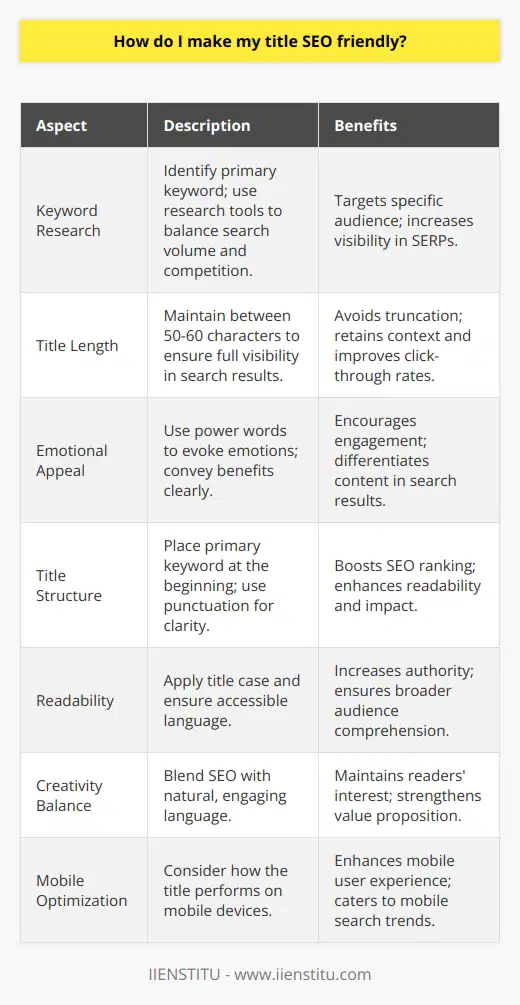
What is an example of a title tag in SEO?
Title Tag Example in SEO
Definition and Importance
A title tag in SEO serves as an HTML element that specifies the title of a web page. This crucial component of on-page search engine optimization holds immense importance, as it directly impacts a webpage's search engine rankings and click-through rates. Title tags provide users and search engines with concise yet informative descriptions of the web page content, significantly contributing to enhanced visibility and user experience.
Example of a Title Tag
To better understand a title tag in context, consider this hypothetical situation where a blog post discusses various techniques for improving time management skills. A well-crafted title tag that would effectively cater to the search engine algorithms might be: '10 Time Management Techniques for Increased Productivity.' This title tag is specific, relevant, and conveys the essence of the blog post, increasing the likelihood of higher search engine rankings and user engagement.
Characteristics of Effective Title Tags
An effective title tag possesses several noteworthy characteristics that ensure its success in search engine optimization:
Keyword-centric: Incorporating the primary keyword(s) of the blog post into the title tag will enable search engines to better understand and rank the content accordingly.
Character limit: A title tag should ideally not exceed 50-60 characters, as search engines typically truncate longer titles, negatively impacting user experience.
Uniqueness: A unique and engaging title tag will differentiate the blog post from myriad other web pages discussing similar topics, thereby increasing its search engine visibility.
Readability: A well-structured and easy-to-read title tag will attract users and encourage them to click on the link, ultimately leading to higher click-through rates and improved search engine rankings.
Branding: Including the brand or website name within the title tag can enhance brand awareness and assist users in their online navigation.
Optimizing the Title Tag
To optimize a title tag for search engines, a few essential considerations should be taken into account:
Keyword research: Conducting thorough keyword research is vital for finding relevant keywords that can improve a title tag's performance and increase organic search traffic.
Consistency with content: The title tag should accurately represent the content of the blog post, adhering to truth-in-advertising guidelines and preventing user dissatisfaction.
Testing variations: Periodically reviewing and testing different title tag variations can yield valuable insights into their search engine performance and potential areas of improvement.
In conclusion, an operative title tag in SEO can dramatically enhance a blog post's search engine rankings and visibility, provided it incorporates relevant keywords, adheres to character limits, and exhibits readability and uniqueness. Effective title tag optimization can lead to substantial improvements in website traffic and overall online presence.
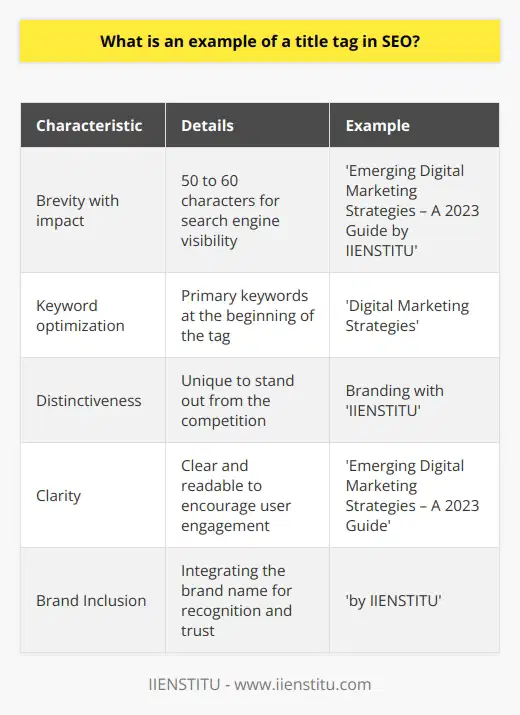
What is the difference between title and title in SEO?
**Understanding Titles in SEO**
The distinction between title and title in Search Engine Optimization (SEO) refers to the difference between the page title and the post title. In this context, the 'page title' is the text displayed at the top of a browser tab or window, while the 'post title' is the headline that appears prominently within the content of the page.
**Page Title: Technical and Structural Role**
The page title has a technical function, serving as a critical element in the underlying structure of a web page. This title is contained within the HTML head tag, and search engines like Google use it to understand the primary topic of the page. Users also depend on it, as it is displayed as the search result's clickable headline, informing them of the page's content. Thus, optimizing the page title with relevant keywords and concise information is essential for improving a website's SEO performance.
**Post Title: Content and Readability Purpose**
On the other hand, the post title is visible within the body of the page, attracting readers' attention and compelling them to read further. It is an essential element of blog posts and news articles, as it communicates the central idea of the content in a relevant, engaging manner. Online content creators should optimize the post title for both human users and search engines by using relevant keywords, employing catchy and informative wording, and maintaining a clear, concise structure.
**Balancing Both Titles for Optimal SEO**
Nurturing a harmonious balance between the page title and post title is crucial for SEO success. While both titles should be unique, they must also complement and align with each other, ensuring a consistent representation of the page's content. Understanding how each title functions and their respective influences on search engine ranking and user engagement are vital in developing an effective SEO strategy.
In conclusion, the difference between title and title in SEO lies in the distinct roles they play within a web page. The page title is responsible for the technical and structural aspects, while the post title is focused on content and readability. By carefully crafting and balancing both titles, content creators can significantly improve a website's SEO performance and overall reader engagement.
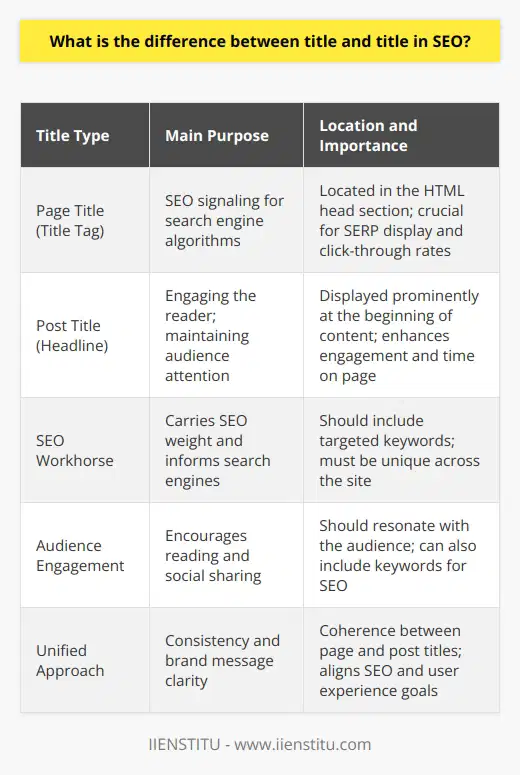
What makes a good SEO title?
Characteristics of a Good SEO Title
Keyword Inclusion
A good SEO title typically begins with effectively incorporating the focus keyword or phrase, as this helps search engines identify its relevance to user queries. This optimizes the likelihood of the title being ranked higher in search results, thus increasing visibility and click-through rates for the target audience.
Clarity and Brevity
An effective SEO title is clear, concise, and accurately conveys the primary topic or central theme of the blog post. Keeping the title short and accurate not only assists with search engine optimization but also makes it easier for readers to understand the subject matter and appreciate its value.
Elicit Emotion and Curiosity
To drive user engagement, an SEO title should aim to elicit an emotional response or spark curiosity within the reader. This enables the title to become more captivating, encouraging potential readers to click on the link and read the blog post. Additionally, a title that invokes a strong emotional connection with the reader is more likely to be shared on social media, further increasing visibility.
Incorporation of Numbers
Integrating numbers or statistics in the title has proven to be effective in gaining reader attention. For instance, using quantifiable statements such as '10 ways to improve' or '5 benefits of' can enhance the appeal of the title, suggesting that the blog post provides clear, actionable information for the reader.
Strategic Use of Power Words
Employing power words, or strong, descriptive terms, can significantly enhance the effectiveness of an SEO title. These words should be carefully chosen to create an impact on the reader and stimulate their interest in the content, which ultimately results in higher click-through rates.
In conclusion, creating a good SEO title necessitates the skillful blending of keyword inclusion, clarity, and brevity, as they work in tandem to increase search engine rankings and user engagement. To further optimize the title, eliciting emotional reactions, incorporating numbers, and utilizing power words are critical strategies for capturing reader attention and driving interaction with the blog post.
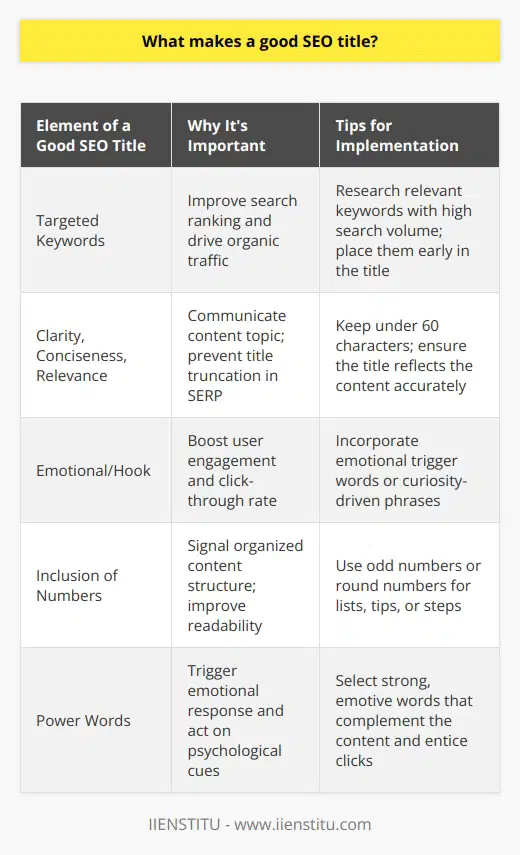
What does SEO title mean?
**Definition of SEO Title**
An SEO title refers to the HTML element that specifically conveys the title of a webpage. It is a critical component of search engine optimization, as it not only aids search engines in understanding the content on a page, but also plays a significant role in a user's decision to engage with the website. Considered among the most important on-page SEO components, an effective SEO title must strive to be informative, concise, and appealing to users, thus increasing organic traffic and improving search engine rankings.
**Characteristics of an Effective SEO Title**
A well-crafted SEO title should:
Be Unique: Each webpage must have a distinct title to ensure that search engines properly index the content and users can distinguish between pages. Avoid duplicate titles to maximize impact.
Be Relevant: Ensure the title accurately reflects the content on the webpage. Misleading titles may deter user engagement and potential search engine penalties.
Include Keywords: Incorporate primary keywords early in the title, as search engines assign more weight to the first few words. This approach facilitates content indexing and ranking improvement.
Adhere to Length Constraints: While there is no universal rule for the optimal length, SEO titles should generally remain under 60 characters to avoid truncation. Digital marketers must balance the need for inclusion of keywords with that of maintaining readability.
Employ Persuasive Language: Encourage users to click by using compelling, yet concise language. A well-written title can significantly influence click-through rates and overall website success.
**SEO Title Impact on Ranking**
Though search engines utilize numerous factors to determine website rankings, an effective SEO title contributes significantly to this process. As a result, paying close attention to titles when crafting a blog post is crucial. When content creators optimize their titles, they allow search engines to identify relevant information, index it accurately, and rank the page higher in search results. Consequently, a well-optimized title positively impacts organic traffic, ensuring the blog post reaches its goals and users can easily locate the information they seek.
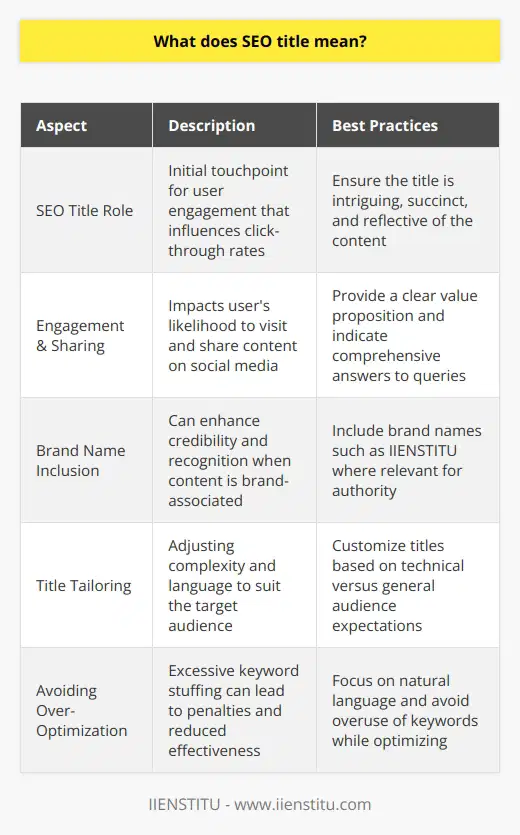
How can an SEO-friendly title improve a website's visibility and click-through rates?
### Impact of SEO-Friendly Titles
An SEO-friendly title holds paramount significance in elevating a website's visibility and click-through rates. This phenomenon transpires as search engines, such as Google, place considerable emphasis on highly relevant, targeted keywords incorporated within the title tags. Thus, a title that incorporates such pertinent keywords can indisputably bolster a website's ranking in search engine results pages (SERPs).
### User Attraction and Readability
Moreover, an articulate, SEO-optimized title fosters user attraction and comprehensibility, as the title explicates the content's core message. It renders a content synopsis in a nutshell, simplifying user navigation and enhancing the browsing experience. Straightforward and readable titles enable potential visitors to discern the precise subject matter and entice engagement with the content.
### Enhanced Click-Through Rates
SEO-friendly titles are inherently conducive to improving click-through rates (CTRs). By encapsulating the content theme, such targeted titles capture users' attention and pique their interest, compelling them to explore the website further. In fact, research suggests that well-curated, optimized titles can boost organic traffic, thereby creating a virtuous cycle that further enhances SERP rankings.
### Key Components of SEO Titles
To devise an optimal SEO title, it is critical to adhere to certain elemental practices. Firstly, incorporating the primary keyword near the title's beginning maximizes its relevance to search engines. Secondly, maintaining a character count of around 60 ensures that the title remains coherent, powerfully delivering the message without truncation in SERPs. Finally, the inclusion of numbers, brackets, and emotive words can heighten curiosity and user interest.
### Conversion Advantages
SEO-friendly titles not only augment a website's visibility and CTRs but also proffer consequent advantages related to conversions. A clear, relevant title paves the way for improved user engagement and content interaction, fostering trust in the website. In turn, this can generate increased leads, sales, and subscriptions, fostering business growth and enhancing return on investment (ROI) in content marketing efforts.
In summary, an SEO-friendly title is a crucial ingredient in bolstering a website's visibility, elevating CTRs, and ultimately enhancing overall performance metrics. Employing prudent practices that espouse targeted keyword usage, optimal character count, and compelling language can help create captivating titles, propelling your website to newfound heights in SERP rankings and conversion rates.
